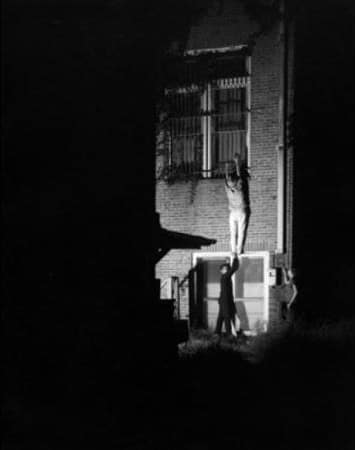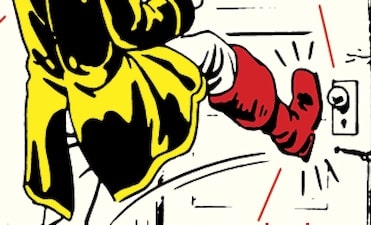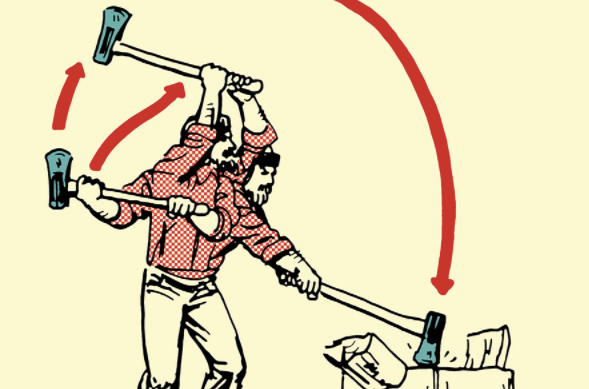
A few months ago I published an article on how to pick a lock. One of the reasons I showed folks how to do that (besides fulfilling a goal to become more like Jason Bourne) was to demonstrate how locks provide an “illusion of security.” Locks make you feel safe, but if someone wanted to get into your house, they could easily pick their way inside.
Hopefully, the takeaway from that post was that you can’t just rely on locks as your only means of home security. You need to utilize other tools and tactics in order to create multiple layers of defense.
Each year, there are over 2 million home burglaries committed nationwide. Today I’ll share a complete guide to making your home more secure and decreasing your chances of becoming a victim of this crime. I’ve included a whole gamut of different options and steps you can take. The tips range from the cheap and easy, to the more expensive and involved. Only you can decide, based on your personal circumstances and inclinations, how much time and money to invest in buttressing your home against the possibility of invasion and theft.
Understand the Mind of a Criminal: Time, Noise, and Visibility
Most burglars are criminals of opportunity. They’re typically only going to target homes they can access easily without being detected. Sociologists that have interviewed burglars have found three common factors they use to determine whether or not to rob a home: time, noise, and visibility.
Burglars want to get in and out of a house as quickly as possible. The longer it takes to enter a home, the more likely someone will notice and call the police. So the harder you make it to gain entry, the better. Unfortunately, many people make it way too easy for a criminal to burgle them. Some research suggests that about 30% of all burglaries are through an unlocked door or garage. While it’s easy to pick a lock, it takes much more time than walking through an unlocked door or window. That’s why you should always lock all of your home’s potential entry points; it’s the simplest way to add a buffer of time.
Besides the time factor, burglars look at whether they can do their filching without being noticed. Barking dogs and home security systems will bring unwanted attention to a burglar due to the noise they create. Consequently, burglars will often skip homes with these features.
On the other hand, homes that are poorly lit at night or have lots of trees blocking the main entrance or windows make for enticing targets because they provide a cloak for thieves.
Time, noise, visibility. Part of a solid home security plan is increasing all three of these factors. Which areas do you need to improve upon the most? To figure that out, you need to:
Case your joint. The first step to improving your home security is to find your home’s weaknesses. And the way you do that is to look at your place as if you were a criminal. Keep in mind the three factors we just discussed and case your joint. Do it during the day and the night and ask yourself questions like:
- Are there areas around my home that would offer cover for a bad guy to break in without being seen?
- Is my house well-lit at night?
- Do I have any unlocked doors or windows?
- Can I easily see valuables in my home from the street?
- Do the people in my home have routines that would make it easy for a burglar to figure out when would be the best time to hit my house?
Be ruthless with yourself as you try to think like a burglar would.
General Home Security Measures
Get to know your neighbors. One of the best security measures you can take is to get to know your neighbors and ask them to keep an eye out for strangers around your house. Convicted burglars often report that one thing that would thwart their plans was a nosey neighbor asking what they were up to. Burglars will usually go after a home if they think they can get away with it; if they know they’re being watched, they’re less likely to follow through.
Install a home security system. The research shows that homes without a security system are three times more likely to be broken into than homes with one. Home security systems obviously deter would-be thieves by bringing audible attention to their break-in attempts. They also automatically dispatch the police to your home (though it’s important to note that it could be up to 30 minutes to an hour before they get there). Besides monitoring for breaches, many security companies also offer fire and carbon monoxide detection, as well as features that allow you to control your home’s lighting and appliances while you’re away.
If you can’t afford a home security system, consider installing alarms that, once set, emit a loud noise whenever someone opens a door or breaks a window. These types of alarms are pretty affordable — look to spend between $10 and $50 for each one. If you don’t want to do that, at least put up generic “This home is protected by Acme Home Security” stickers in different windows around your house. It might not deter all burglars, but it may cause some to reconsider making you a target.
Get a dog. While you shouldn’t rely on your dog as your primary means of home security, having a barking (or yelping) dog in the backyard or in your house will make bad guys think twice about breaking into your home. It’s not so much the fear of being attacked (though if your dog is a Rottweiler, that’s likely a factor), but the prospect of the barking drawing attention to their break-in.
Keep the outside of your house in tip-top shape. Regular home maintenance and upkeep serves two purposes. First, it keeps your home looking like it’s occupied. An unmowed yard could be a signal that no one is home. Second, you want to keep shrubs and trees trimmed and pruned to eliminate any possible hiding places for potential bad guys.
Keep the outside of your house well-lit. Bad guys don’t want to be seen, so do what you can to deny them the cover of darkness. You want to have lighting on parts of the outside of your house that would allow your neighbors to see a suspicious person within 100 feet of your home. Turn your front door light on at dusk, as well as any other lights near entry points (better yet, put them on a timer). If you have tall trees around your home, you might also consider installing timed floodlights in their branches that come on at night. Motion-activated floodlights near shadowed areas create extra security as well. They’ll only come on when someone’s activity in the area trips it. Having a bright light suddenly shown on them might scare off a bad guy.
All of these lights not only keep would-be robbers away, but help friends and family safely navigate to your front door at night.
Watch what you’ve thrown out in the trash. One way bad guys will “window shop” your house is to check for any big cardboard boxes for appliances sitting on your curb. If you make any significant purchases, make sure to cut up the cardboard box it came in so it can fit in a trash bag or a recyclables container. Also, before you throw away any bills or bank statements, shred them to stave off identity theft.
Be careful who you let into your home. Anytime you let someone into your home, you give them the opportunity to steal from you right then and there or to scope out your valuables and make preparations to come back later to swipe them.
So be very careful who you let into your home.
When you need to be particularly on guard is when you hire service providers like repairmen, contractors, cleaners, babysitters, etc. Always ask for references and vet them thoroughly. You may consider doing a background check as well.
Bonding domestic employees is another option. A fidelity bond is a type of insurance that covers the policyholder for losses that come about by fraudulent acts by your domestic employee. Another benefit of a fidelity bond is that the insurance company does an additional background check on the potential employee. Talk to your insurance company about this.
When you do have repairmen or contractors come to your house, hide your valuables before they get there. Never give them a key (they could easily make a duplicate), and only provide them access to the parts of the house that they’re working on. And don’t disclose future vacation plans either.
Every time the workers call it quits for the day, go through your home and do a quick inventory. Check to see if your valuables are still there, but more importantly, check to see if your doors and windows are still locked. A common ruse by criminal contractors is to unlock doors and windows so that they can come back later to burgle.
Avoid hiring unsolicited help. A common scam criminals run is called “imposter burglaries.” A pair of hucksters knock on your door offering some service — tree trimming, gutter repair, painting, etc. One of the scam artists will lure you outside to talk to you about your trees or whatever, while the other one enters your home to fleece the easy pickings. Bottom line: If you didn’t call someone to come out to your home, don’t engage with them.
Always lock your doors and windows. Sure, they can be easily picked or bypassed, but remember, 30% of all burglars enter a home through an unlocked door or window. While locks aren’t foolproof, they do make breaking into your home a little more time consuming, and thus less desirable for a bad guy.
Securing Doors
Reinforce your doors. Doors are a home’s first point of entry, so consider buttressing their security with the following measures:
- Make sure the hinges of all entry doors are on the inside of the house. If the hinges are on the outside, would-be home invaders can pop them off to break in.
- Replace strike plate. The strike plate is the metal rectangle on the inside of the door into which the deadbolt or door latch is inserted when you shut it. When crooks kick in a door, the strike plate is often the part that gives first. If your home is older, the strike plate is likely worn or loose; replace it.
- Install security film on glass panes. Doors with lots of glass panes look pretty, but are easy to compromise. While burglars try to avoid breaking glass when they can (too much noise), if they think they can do it without bringing too much attention to themselves, they will. If you do have substantial amounts of glass on your door, you might consider putting “security film” over the panes. It’s a clear, virtually undetectable, tear-resistant film that holds pieces of glass together when a pane is shattered, making breaking through a window much more difficult.
- Check to see if your doors fit the frame snugly. Criminals can insert crowbars in the gap between the door and the frame to pry it open.
- Reinforce French doors. French doors look fancy, but they have a few security flaws. These include not only their vulnerable glass panes, but the split door set-up as well, which makes them easy to kick open. You can buy a kit that can help reinforce French doors.
- Put a bar in your sliding glass doors. Sliding glass doors typically have ineffective locking mechanisms, so they’re often a favored entry point for burglars. One thing you can do to buttress them is to add a lock that vertically bolts into the floor and the top frame. If you’re too lazy for that, just put a wooden dowel in the bottom track to prevent the door from sliding open. Because sliding doors also typically have a lot of glass, you may consider covering it with security film as well.
Upgrade your locks. When I published the aforementioned article on how to pick locks, several folks asked if there were better locking systems on the market that were more difficult to pick. I asked Matt Fiddler, owner of SEREPICK and the man who taught me how to pick locks, for his recommendations.
According to Matt, the locks you buy at Home Depot or Lowes can easily be picked by someone with rudimentary lock-picking knowledge. If you want something more secure, you’re going to have to spend more money.
Matt recommends locks from Abloy Protec, Medeco, Mul-T-Lock, and BiLock. “Each of these locks offer multiple layers of security. The keys are very difficult to duplicate and the tools you need to compromise (pick/bump) these locks aren’t commonly available on the market.”
You can find all of these high-security locks at securitysnobs.com. Look to spend $100-$300 per lock. You’ll have to decide if that sort of investment is worth it to you or not.
If you have doors with glass panes, make sure they’re secured with double-cylinder locks. This kind of lock requires a key from both the outside and the inside, and prevents a burglar from breaking the glass and entering by simply reaching in and toggling the lock’s thumb-turn. Of course, to get the security that comes with a double-cylinder lock, you need to leave the key out of the lock or else the bad guy can break the glass and turn the key.
One thing to keep in mind with double-cylinder locks is that in the event of a fire, they can delay you and your loved ones from getting out. Make sure you have a key in an accessible place (to you, not a bad guy) near the door. Also, check with your city’s regulations. Some towns prohibit more than one double-cylinder lock in a dwelling due to the possible fire hazard.
If you live in an apartment, make sure that the locks were changed when you moved in. Otherwise, the previous tenant or others associated with them could enter your dwelling with an old or duplicate key.
Securing Windows

Always lock windows. Burglars typically don’t like to break glass, so keep your windows locked.
Consider security film. The film makes the glass harder to break through, increasing entry time and noise that will bring attention to the bad guy.
Consider security bars. If you don’t care too much about aesthetics and live in a particularly dangerous area, you might consider installing security bars on your windows. Even if the bad guy breaks the glass, the bars prevent him from entering the home.
Keep in mind that while it prevents bad guys from getting in, the bars also prevent you and your family from getting out in the event of a fire. There are quick release devices available that are installed on the inside of the house that allow you to release the bars with the touch of a button.
Use shutters and curtains. Robbers will often “window shop” to figure out which home offers the most bang for the buck. To prevent snooping, use shutters and curtains liberally.
Plant thorny bushes near windows. Not only does this make it more difficult for a would-be burglar to access your window, but it can also serve as an evidence collection tool in the event of a successful break-in. Blood, skin, and torn clothing in the bush can be used to track down the bad guy.
Securing the Garage
Keep your garage door closed. An open garage door with bikes, tools, and toys inside just screams “rob me!” All a burglar has to do is run in, take what he wants, and run out. And you won’t even notice because you’re inside watching The Godfather marathon on AMC. Unless you’re outside working, keep your garage door shut.
Make sure to lock access doors. The doors that go into your garage and from the garage into your home should be secured just as much as your front door. Keep them locked and reinforce if necessary.
If you park your car in the driveway, don’t leave the garage door opener in it. A common tactic used by burglars is to break into a car parked in the driveway, grab the garage door opener, use it, and clean out the garage. This happened to me and a few of my neighbors last summer. Had several power tools, a power vac, and a ratchet set stolen.
If you’re going to park in the driveway, take the garage door opener in with you.
Lock your garage door at night and when gone for extended periods of time. Most garage door systems have automatic locking mechanisms. Use it. If I had used the lock on my garage, I probably would still have my power drill. Lock it at night and while you’re gone on vacations. You might even consider using padlocks for added security.
Secure garage quick release lever. If your garage has windows, you have a security vulnerability. All a bad guy has to do is break the window and pull the security release cord on the door, allowing for easy access and escape. One way to prevent this break-in method is to take a zip tie and thread it through the release lever. It makes it much harder for a bad guy to release the latch because he doesn’t have the adequate leverage from the position in which he’s sticking his arm into the garage. If you need to release the latch, pulling down hard on the cord will break the zip ties.
While You’re on Vacation
Burglars greatly prefer to hit an unoccupied house, so a residence in which the owners are on vacation makes for a primo target. Secure your house while you’re away with the following measures:
Have your neighbor keep your house looking lived-in. When you’re away on vacation, your neighbor can play a key role in making your house appear occupied. A few things you can ask him or her to do while you’re gone:
- Bring in your mail and newspapers. A stack of mail in a mailbox and newspapers piling up in the driveway is an indicator to burglars that you’re away and that your home is an easy target. So have a neighbor collect it while you’re on vacation, and ask them to check for fliers on the door too. One trick burglars use to determine if a house is unoccupied is to leave a flier and then check back to see if it’s been taken inside. If the flier’s still there, the scheming thief assumes no one is home.
- Take your trashcans to the curb on garbage day and bring them back into the garage when they’re empty. Again, it’s important to maintain the appearance of your home being occupied.
- Feed/walk your dog. Security experts don’t recommend kenneling your pooch while you’re away. First, as we mentioned earlier, barking dogs are a great way to bring attention to uninvited guests. And second, a burglar who’s been casing your home will certainly notice if your dog suddenly disappears.
- Check on your house. Simply have your neighbor keep an eye on your house and report any suspicious activity to you.
Put lights and appliances on a timer. You’ve already got your exterior lights on a timer; having interior ones, as well as appliances like your television or radio on a timer as well can help provide the illusion that somebody is home when you’re actually away.
You want to give the appearance of randomness with your timer schedule. If a bad guy casing your home notices that your lights and TV come on at exactly 6PM every single day, he’ll correctly assume they’re on a timer. So make sure to vary the activation time. You’ll also want them to turn off at a certain point in the night and then come back on early in the morning.
Many home security companies offer services that let you turn your home’s lights on and off from your smartphone while you’re on vacation. You don’t even need a home security system plan for that. You can buy smart plugs that you connect to your home’s WiFi and then control from your phone.
Don’t turn off the A/C completely while you’re on vacation. While it will save you money, an A/C unit that never turns on, even when it’s crazy hot outside, could signal to bad guys that no one is home. Instead of turning your A/C completely off, dial back your thermostat’s settings, so it doesn’t come on until it’s 80 or 85 degrees inside your home. You can also have it come on just during the day and have it shut off at night.
In Case You Do Get Robbed

No matter how many layers of security you place in your home, there’s always a chance a bad guy will be able to get in and get your stuff. You need to prepare for that contingency. Here’s how:
Catalog expensive items and engrave ID number on them. Make a list of all your expensive items in a spreadsheet in Google Docs: firearms, cameras, laptops, TVs, video game systems, jewelry, etc. If you end up getting robbed, this record will help you in filing a claim with your insurance company for reimbursement on what was stolen.
If possible, engrave your driver’s license number into a hidden/obscure part of your valuables. Bad guys typically try to pawn stolen goods. If you can provide an ID number that’s on your stolen items, police can use that to track down and possibly recover your property.
Use a safe for valuables. Store valuable items like jewelry, gold coins, etc. in a safe positioned in a hidden, harder-to-reach spot.
Ideally, you want to keep your firearms in a heavy, fireproof gun safe. Something like that is just too heavy for a burglar to walk out with. If you don’t have one of those, but rather have a small cabinet (like the Sentry Safe), make sure to fasten it to a wall stud.
If you arrive at home, and your door is open or things appear out of place, don’t go in. Leave and call 911. Confronting or trapping a burglar in your home is a dangerous position to be in. Clearing a house is an option for those who have been well-trained in this skill; but that’s a whole ‘nother subject.







